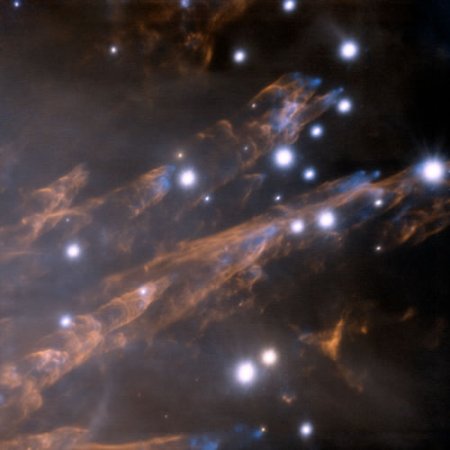When you can work with a deformable mirror that compensates for atmospheric distortions, wondrous things can emerge. The Gemini Observatory (Mauna Kea, HI) used such a system coupled with a laser guide star as reference to produce an image of fast-moving ‘bullets’ of gas and the wakes they leave as they move through molecular hydrogen in the Orion Nebula. Some 1500 light years away from Earth, this stellar nursery has much to teach us about the birthing of stars.
What we’re looking at appears to be the movement of clumps of gas that have been ejected from within the nebula by some kind of violent event. They’re moving outward at about 400 kilometers per second, vast gaseous agglomerations roughly ten times the size of Pluto’s orbit around the Sun. At the tip of each clump you can see the blue glow of iron atoms shock-heated by friction with the surrounding cloud. The long wakes of their motion appear as orange smudges in the image below.

Image: This composite image at infrared wavelengths was obtained using the Gemini North laser guide star system in conjunction with the ALTAIR adaptive optics system and the NIRI near-infrared imager. The image shows the Orion “bullets” as blue features and represents the light emitted by hot iron (Fe) gas. The light from the wakes, shown in orange, is from excited hydrogen gas. The images were taken at f/14 through the Fe II, H2 1-0 and K-band filters and then combined into one color composite image. The field of view of this image is about 50 arcseconds across and structure on 0.1 arcsecond (2 pixel) scales is visible. Credit: Gemini Observatory.
These are young features, their age estimated at less than a thousand years since ejection. The beauty of this work is that the imagery is precise enough for astronomers to follow developments as the bullets of gas push ever outward through the Nebula. Says Michael Burton (University of New South Wales):
“What I find stunning about the new image is the detail it shows, which was blurred out in any previous studies, revealing the structure of the bullets and their trailing wakes as they run into the surrounding molecular cloud…[S]mall changes in the structures are expected from year to year as the bullets continue their outward motion.”
Burton’s fascination is well founded, as he and David Allen (Anglo-Australian Observatory) were the first to explain the origin of the Orion bullets some 15 years ago. But beyond the bullets themselves, the exciting news is the progress being made in adaptive optics. Gemini’s system settles down the atmospheric jitter that makes stars seem to twinkle. The laser guide star it creates is an artificial reference point that allows it to measure how the atmosphere is distorting near-infrared starlight and correct for it. As we perfect these technologies, long observing runs that might otherwise prove impractical for space-born telescopes will become available to astronomers here on Earth.


The Gemini Deep Planet Survey — GDPS
Authors: David Lafreniere, Rene Doyon, Christian Marois, Daniel Nadeau, Ben R. Oppenheimer, Patrick F. Roche, Francois Rigaut, James R. Graham, Ray Jayawardhana, Doug Johnstone, Paul G. Kalas, Bruce Macintosh, Rene Racine
(Submitted on 29 May 2007)
Abstract: We present the results of the Gemini Deep Planet Survey, a near-infrared adaptive optics search for giant planets and brown dwarfs around nearby young stars. The observations were obtained with the Altair adaptive optics system at the Gemini North telescope and angular differential imaging was used to suppress the speckle noise of the central star. Detection limits for the 85 stars observed are presented, along with a list of all faint point sources detected around them. Typically, the observations are sensitive to angular separations beyond 0.5″ with 5-sigma contrast sensitivities in magnitude difference at 1.6 micron of 9.6 at 0.5″, 12.9 at 1″, 15 at 2″, and 16.6 at 5″. For the typical target of the survey, a 100 Myr old K0 star located 22 pc from the Sun, the observations are sensitive enough to detect planets more massive than 2 Mjup with a projected separation in the range 40-200 AU. Second epoch observations of 48 stars with candidates (out of 54) have confirmed that all candidates are unrelated background stars. A detailed statistical analysis of the survey results is presented. Assuming a planet mass distribution dN/dm ~ m^{-1.2} and a semi-major axis distribution dN/da ~ a^{-1}, the upper limits on the fraction of stars with at least one planet of mass 0.5-13 Mjup are 0.29 for the range 10-25 AU, 0.13 for 25-50 AU, and 0.09 for 50-250 AU, with a 95% confidence level. Without making any assumption on the mass and semi-major axis distributions, the fraction of stars with at least one brown dwarf companion having a semi-major axis in the range 25-200 AU is 0.018_{-0.014}^{+0.078}, with a 95% confidence level. The observations made as part of this survey have resolved the stars HD 14802, HD 135363, HD 160934, HD 166181, and HD 213845 into close binaries for the first time.
Comments: 64 pages, 13 figures, 6 tables. Submitted to ApJ
Subjects: Astrophysics (astro-ph)
Cite as: arXiv:0705.4290v1 [astro-ph]
Submission history
From: David Lafreni\`ere [view email]
[v1] Tue, 29 May 2007 20:14:44 GMT (802kb)
http://arxiv.org/abs/0705.4290
The Orion Nebula is 200 light years closer to Earth than
previously thought:
http://kencroswell.com/OrionNebulaDistance2.html
This means that the main sequence stars in the nebula are
twice as old as previously thought.
ljk,forgive a little levity(its been a rough day).so the orion nebula is 200 light years closer than previously thought. well good news! fits right in with our moon mars and beyond program!! arrrggh! sorry,maybe just a touch too much beyond mars! but thank you anyhow george